
Updated on • 17 Sep 2024
EU Drone Regulations, Licences And Training
... Read More

New drone laws have started throughout Europe to help define the safe operation of UAS in European skies (EU and EASA Member States).
One of the key changes is that they adopt a risk-based approach. Therefore, they do not distinguish between recreational or commercial flights.
Instead, the weight and specifications of the drone, as well as the operation, are factors which shape which drone licence you need and where you can fly.
This blog offers an overview of the new EU drone rules. Click the link for a more specific article on UK drone laws which have also changed to coincide with the updated EU regulations.
EU Drone Regulations - Registration
The EU drone regulations came into force on December 31, 2020.
So, what is there to know?
The first step as a drone operator or pilot is to register in the country you live, or primarily work.
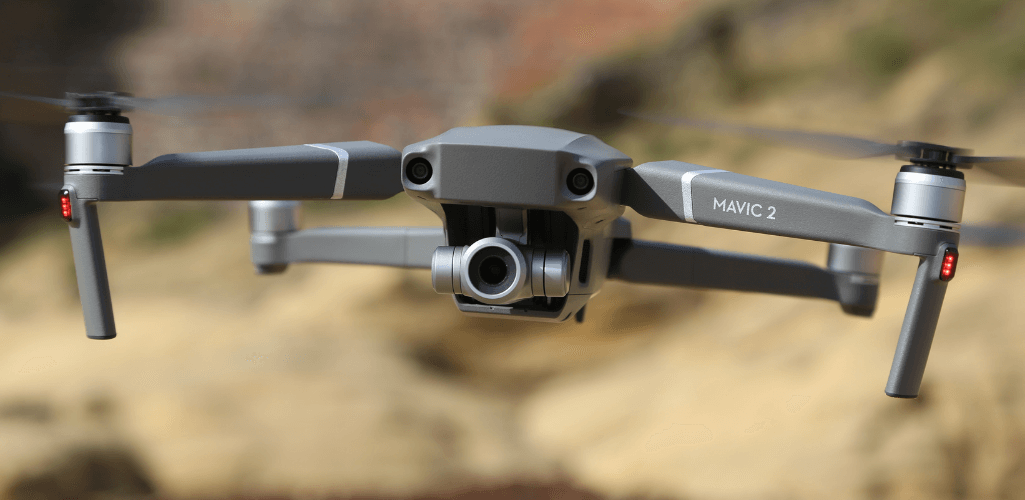
You only need to register once, regardless of how many drones you have. The registration period is defined by your National Aviation Authority.
However, you do not need to register yourself if your drone(s):
Weighs less than 250g and has no camera or other sensor able to detect personal data; or
Even with a camera or other sensor, weighs less than 250g, but is a toy.
After registering, you will receive a 'drone operator registration number'.
This needs to be displayed on all the drones you own. Also upload this into the drone's remote identification system.
This unique registration number will be valid in all other EASA member States.
Click to read specifically about UK drone registration.
EASA Drone Regulations - Knowing The Laws
Having registered, it is vitally important to know the laws and understand where you can and cannot fly.
Under the laws, three new categories have been introduced, based on the risk of the operation.
These are:
Open: Presents low risk to third parties.Specific: More complex operations or operational aspects which fall outside the Open Category.Certified: Very complex operations; equivalent risk to that of manned aviation.
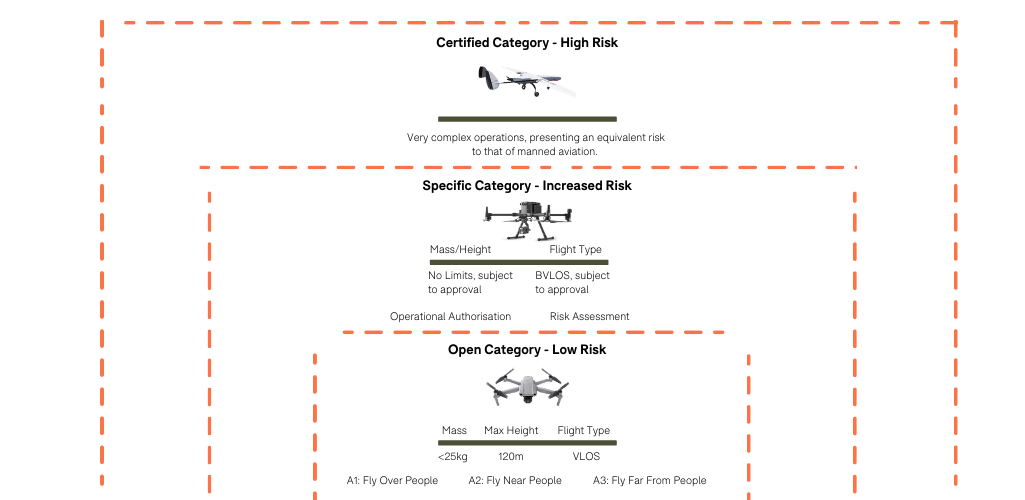
Open Category
The Open Category is further split into three subcategories:
A1: Fly over people but not over assemblies of people;A2: Fly Close To PeopleA3: Fly Far From People
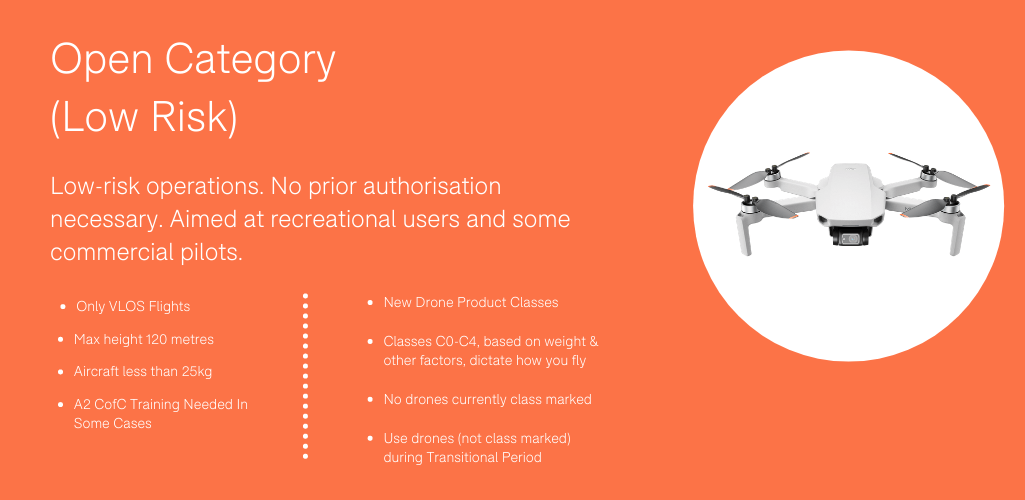
Drone Classes And Transitional Period
New drone class classifications (C0-C4) have been introduced.
These classes are based on various criteria and will impact on where you can fly within the Open Category.
However, as no drones currently have these class markings, a Transitional Period is running to enable non-class-marked drones to be flown in accordance with the new rules.
According to EASA's website, these are the rules for Open Category drones, without class markings, during the Transitional Period in EU member states.
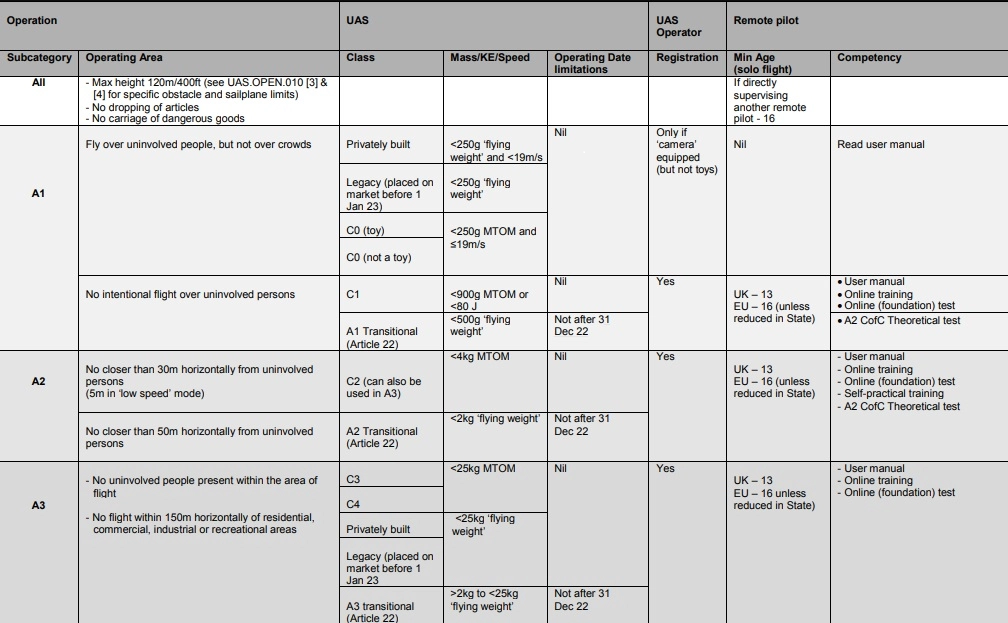
*The minimum age can be lowered by the state to 12, in which case, this new threshold will be valid only in that state.
For specific UK rules within the Open Category, click here, or view the tables below.
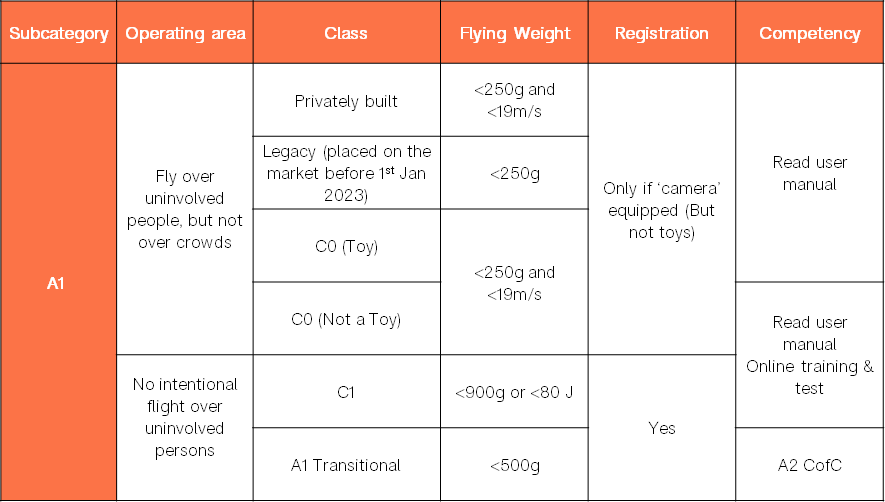
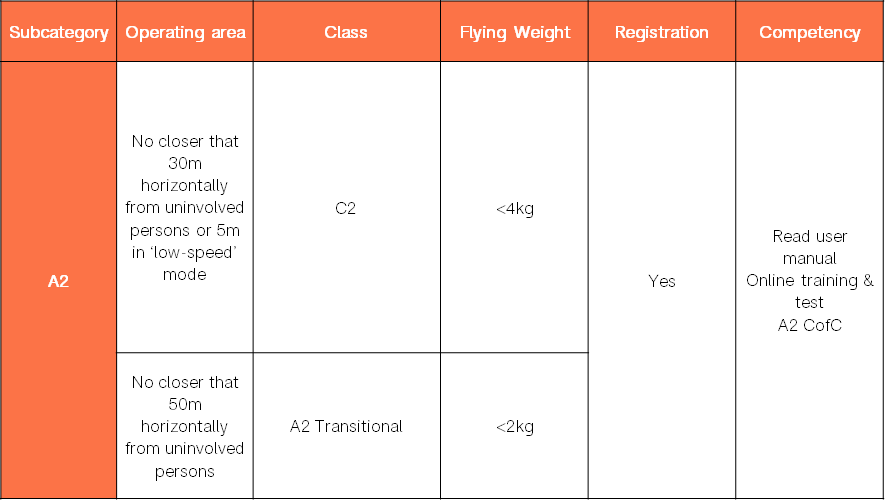
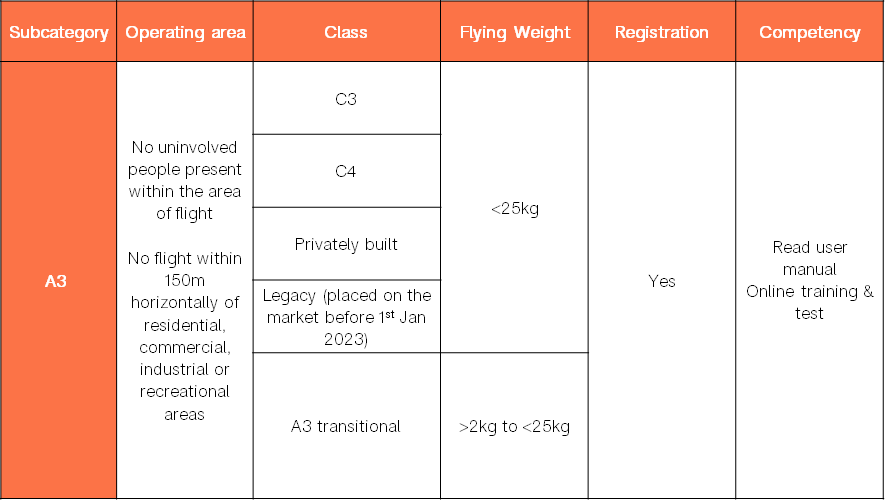
In the UK, the CAA states that the Transitional Period runs until December 31, 2022. For Europe, EASA (European Union Aviation Safety Agency) states that the Transitional Period runs until January 1, 2023.
Regardless of being in the UK or an EU Member State, if a drone does not have a class mark after the Transitional Period, you can continue to use it, but will be subject to these restrictions:
Up to 250g: Subcategory A1.
250g to 25kg: Subcategory A3.
Specific Category
A drone can be operated in the Specific Category when it does not meet the requirements laid out under the Open Category.
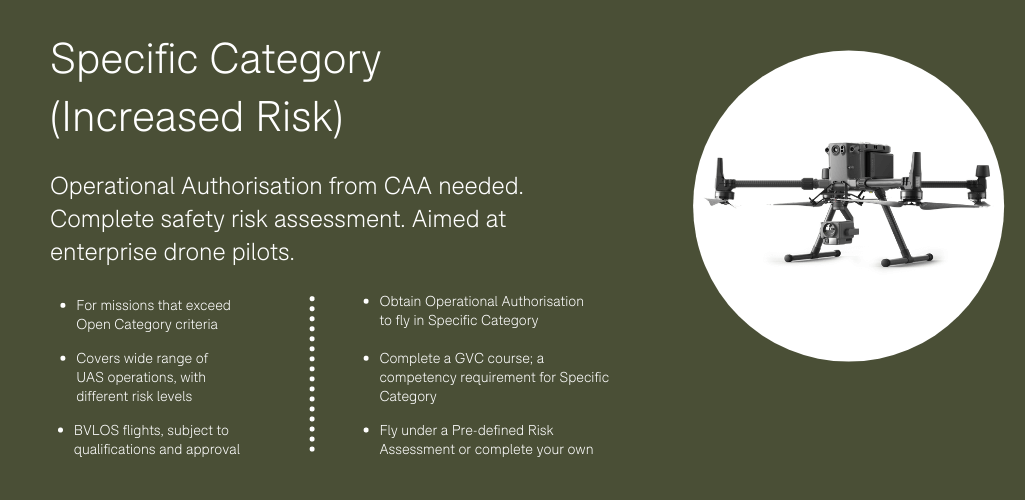
What EU Drone Licence Do I Need?
The type of drone licence required depends on the drone you have and where you intend to fly it.
Open Category
A Certificate of Remote Pilot Competency is required to fly drones in the A2 subcategory or A1 Transitional drones in the A1 subcategory.
It involves a 30-question test and a period of practical flight training.
It is valid for five years.
Click for more information relating to the A2 CofC in the UK.
Specific Category
To operate in the Specific Category, drone operators require an Operational Authorisation from the National Aviation Authority where they are registered, unless the operation is covered by a Standard Scenario.
A Standard Scenario (STS) is a pre-defined operation. Two Standard Scenarios have been published so far.
If the operation falls under the STS, send a declaration to the NAA where you are registered and wait for the confirmation of completeness and receipt.

If, however, an operation cannot be covered by an STS in the Specific Category, then an Operational Authorisation is required.
A key part of this is having a risk assessment approved by the operator's NAA.
Operators can do this themselves, or use a Pre-defined Risk Assessment (PDRA), which cater for the most common operations and help to streamline the process.
Specific Category Training
If the operation falls into a STS, the remote pilot must:
Hold a certificate of remote pilot theoretical knowledge for operation under a Standard Scenario;
Hold an accreditation of completion of the STS-01 practical skill training.
To do so, the remote pilot must complete and successfully pass an online training course.
A certificate for remote pilot competency is valid for 5 years.
For operations in the Specific Category that are not covered by a STS, the training will be defined in the Operational Authorisation provided by the National Aviation Authority.
Please note that Standard Scenarios have not yet been introduced in the UK, so operators will need to apply for an Operational Authorisation, submitting a risk assessment/PDRA. For more details on UK PDRAs, click here.
For Specific Category training in the UK, click here.
Light UAS Operator Certificate (LUC)
EASA also states that another alternative for the Specific Category is using a Light UAS operator certificate (LUC).
Operators can ask the NAA to assess their organisation, and in turn, the NAA may grant permission to allow the operator to self-assess the risk of the operation and self-authorise it.
Will the competency certificate for the Specific Category be recognised throughout Europe?
Yes. According to EASA's website, training conducted in one EASA Member State will be recognised in all others.
In terms of holding an Operational Authorisation, any authorisation given by one Member State will be valid in the rest of Europe.
The drone operator is required to first submit the declaration (if intending to conduct an operation covered by a Standard Scenario) or receive an Operational Authorisation from the National Aviation Authority of the state of registration.
For operations not covered by an STS in the Specific Category, the drone operator must ensure that the mitigating measures submitted in the original risk assessment are appropriate to the new operating environment, or update them as necessary.
What If I Had A Valid Drone Licence Before The New Laws Started?
EASA says that, after December 31, 2020, all existing approvals/certificates/authorisations/declarations issued by National Aviation Authorities will be valid until January 1, 2022.
After January 1, 2022, these must be converted to the EU Regulation. New applications for authorisations/certificate submitted after January 1, 2022, need to follow the new EU Regulation.
For specific UK rules relating to the PfCO, click here.
Rules For Non-EU Residents Flying in Europe
The EASA drone rules were designed to harmonise regulations throughout the Continent.
So, what is the situation for non-EU residents who want to fly in Europe? This is particularly pertinent for those in the UK, who may want to use their drone in the EU following Brexit.
Registration
Firstly, all drone operations which take place within EASA Member States must comply with the EU Drone Regulations.
Non-EU residents are required to register with the National Aviation Authority of the first EU country - known as the host country - they plan to fly in.
A drone operator registration number will then be issued and the corresponding sticker needs to be put on all drones owned.
You must also upload it into the remote identification system of your drone(s).
Importantly, once registered in the host country, the drone operator's registration will be valid across Europe.
So, if you live in the UK and have already registered under the DMARES scheme, but plan to fly in France, for example, you will need to register in France.
Operations In Specific Category
If you intend to operate in the Specific Category, you must submit a declaration for a Standard Scenario or apply for an Operational Authorisation to the National Aviation Authority of the EU Member State(s) where you registered.
If you want to conduct operations in a Member State different from the one in which you registered, you need to follow the same procedure as all other national citizens of the Member State where you registered.
As a non-EU resident, are my competencies for the Open or Specific Categories Recognised In the EU?
Currently, as there is not yet any mutual recognition established between EASA and other countries, in the domain of drones, the training or qualification obtained in your country of residence will not be accepted in the EU.
Therefore, you will have to undergo the required training before you can fly your drone.
New Drone Safety Reporting Portal on ECCAIRS 2
The new European Coordination Centre for Accident and Incident Reporting Systems (ECCAIRS) portal has now been launched.
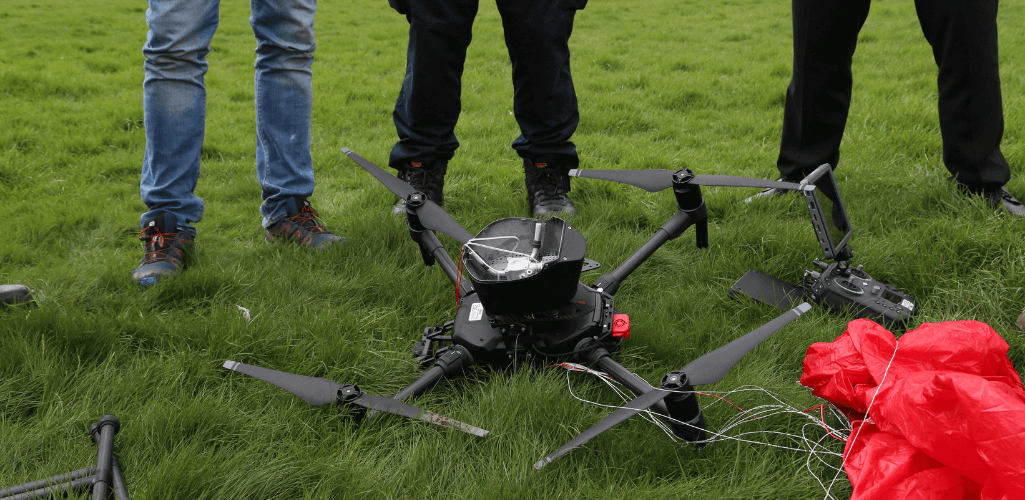
Although the UK has left the EU, Mandatory Occurrence Reporting is still facilitated by the ECCAIRS portal.
UAS Operators should update the Operations Manual; specifically the old avationreporting.eu hyperlink to the new ECCAIRS2 portal.
EASA Drone Regulations - Insurance
You will also need to ensure that you have acquired the required the right insurance for your drone.
It is recommended that you check the requirement for insurance with your National Aviation Authority.
A general rule of thumb is that drone operators are always required to have insurance if you are using a drone weighing above 20kg.
However, most of EASA Member States mandate a third-party insurance also if you are operating a lighter drone. So consult the national regulation.

written by
James Willoughby
James joined heliguy™ in 2018 following a 13-year stint in print and online journalism, having worked on regional and weekly newspaper titles. He is responsible for spearheading heliguy™'s content strategy and social media delivery. James collaborates with DJI Enterprise's European marketing team to coordinate and produce case studies and helps organise events and webinars.